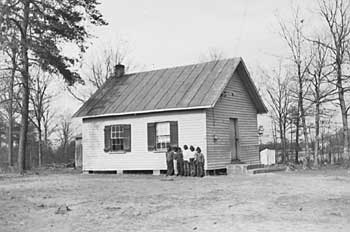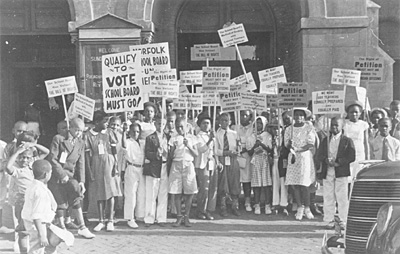
What Was Brown V. Board of Education?
The Road to Brown
The Prince Edward Case
and the Brown Decision
The State Responds:
Massive Resistance
Virginians Respond: Library of Virginia Documents
Additional Resources:
Brown v. Board of Education:
Selected Published Materials
at the Library of Virginia (pdf)
Plessy v. Ferguson: "separate but equal"
In 1892, Homer Plessy, an African American shoemaker, challenged the constitutionality of the Louisiana Separate Car Act, which required railroads to seat black and white passengers in separate cars. The case reached the United States Supreme Court in 1896, and a majority of the judges ruled that the Equal Protection Clause of the Fourteenth Amendment did not prohibit racial segregation. The Court upheld the Louisiana law, stating that black and white passengers were treated equally, since white passengers were forbidden to ride in cars designated for blacks, just as blacks were forbidden to ride in cars designated for whites. Justice John Marshall Harlan dissented and attacked the reasoning behind the law, writing that "every one knows that the statute in question had its origin in the purpose, not so much to exclude white persons from railroad cars occupied by blacks, as to exclude colored people from coaches occupied by or assigned to white persons." The majority decision in the 1896 Plessy v. Fergusonserved as the organizing legal justification for racial segregation for more than 50 years. Segregation by custom (de facto) became segregation by law (de jure). With the support of the legal system, whites strictly determined where African Americans could live, eat, ride, and learn.

African American schools were underfunded and clearly inferior to white schools before Brown. Virginia Department of
Education Records. School Building Services Photographs, Library of Virginia.
Challenges to Segregation
The cases collectively known as Brown v. Board of Education were part of a larger movement among African Americans to achieve equal rights under the law. For example, in 1946 Herman Marion Sweatt, an African American, was refused admission to the University of Texas Law School on the grounds that the state constitution required separate schools for whites and blacks. Sweatt sued, and when the case finally reached the U.S. Supreme Court, the justices ruled in 1950 that the Equal Protection Clause of the Fourteenth Amendment required that he have access to an education equal to that afforded to white students. The Court stated that a separate law school for African Americans was inherently inferior and that Sweatt should be admitted to the University of Texas. Despite this legal victory, most schools for African Americans remained inferior to schools for whites, whether measured in terms of the schools' structure, in curriculum and resources, or in teacher salary. Black schools were poorly constructed and overcrowded. Teacher salaries varied—in Virginia, a white teacher averaged $1,510 in 1945 compared to just $1,075 for a black teacher. Two years before Brown, black school property in Virginia was worth only $384,798 compared to $1,050,746 for whites. Court cases filed in the 1930s attempted to remedy the salary inequities.

Norfolk students' protests. June
1939.
NAACP Papers, Library of Congress. LC-USZ62-117785.
Boycotts, sit-ins, and other forms of protests also began before the Brown decision. African Americans in several Southern cities, including Richmond in 1904, boycotted the recently segregated streetcar systems, only to be defeated. In the 1930s, Samuel Tucker, a young attorney who would later work on many Civil Rights cases, led an attempt to integrate the Alexandria library through civil disobedience. On the education front, Norfolk students protested Jim Crow in that city’s educational system in 1939. The Brown decision augmented and accelerated such protests.

